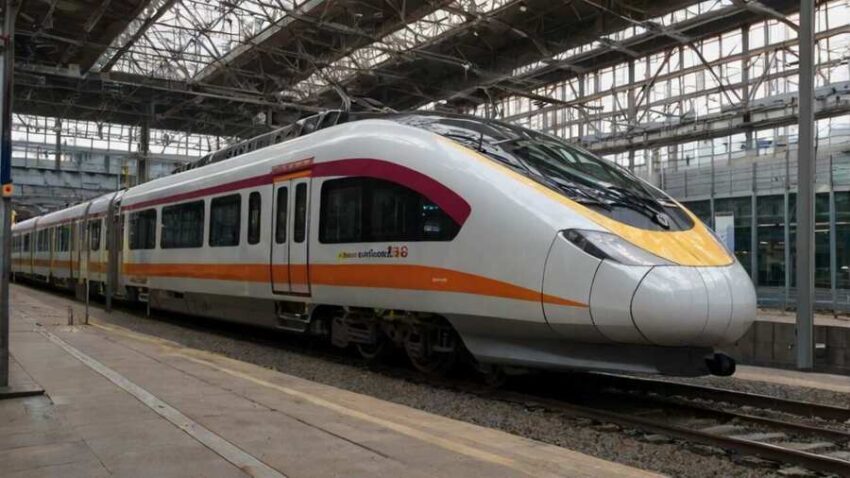Germany Sets Ambitious Plan to Standardize Train Specifications for Cost Reduction, Simplified Maintenance, and a Stronger Domestic Rail Manufacturing Industry
Germany has unveiled an ambitious plan to standardize train specifications across the country, aiming to reduce costs, simplify maintenance, and strengthen its domestic rail manufacturing industry.
Germany has unveiled an ambitious plan to standardize train specifications across the country, aiming to reduce costs, simplify maintenance, and strengthen its domestic rail manufacturing industry. This strategic move is designed to streamline procurement, enhance operational efficiency, and pave the way for a more sustainable rail system. By harmonizing key aspects of train design, such as car length, door width, and technical specifications, Germany seeks to create a unified framework that will not only cut procurement expenses but also improve maintenance processes and foster the growth of its local rail manufacturing sector. This initiative represents a significant step toward modernizing the country’s rail transport network while ensuring a more cost-effective and competitive future for domestic manufacturers.
Germany is set to revolutionize its rail transport system by introducing standardized trains across the nation. This strategic shift is designed to streamline procurement processes, cut operational costs, and speed up the modernization of local and S-Bahn train services. By standardizing train specifications, Germany aims to create a more efficient, cost-effective, and sustainable rail network.
Reducing Costs through Unified Train Specifications
The initiative, which has been spearheaded by a coalition of local transport authorities, involves standardizing the design and specifications of local trains. Key aspects such as train length, door width, and overall design will now follow common guidelines, allowing for bulk purchasing and better coordination between different regions.
Previously, each region in Germany operated with distinct train models, leading to high procurement costs and complicated maintenance processes. With the new plan, train sets can be ordered in larger volumes, reducing per-unit costs. This collaborative approach also simplifies maintenance, as regions will be using the same train models, thus reducing the complexities of sourcing spare parts and managing repairs.
By aligning the specifications of local trains, this new approach is expected to create a more scalable framework for rail transport. As a result, the cost savings generated from this standardization will directly benefit passengers, with potential for reduced ticket prices in the long run. Moreover, the more straightforward maintenance procedures will lead to better reliability and fewer service disruptions.
Greener Rail Services for a Sustainable Future
One of the driving forces behind this initiative is Germany’s commitment to transitioning to more environmentally friendly rail services. As part of the standardization effort, a focus will be placed on promoting battery-electric and hybrid trains, which have been gaining traction across Europe due to their eco-friendly nature. These trains not only reduce carbon emissions but also represent a critical component of Germany’s broader sustainability goals.
The initiative emphasizes the importance of standardizing charging infrastructure to support the growing demand for electric and hybrid trains. Without a common charging infrastructure, Germany risks facing inefficiencies and higher operational costs as regions with incompatible systems struggle to maintain fleet operations. Standardizing charging stations and protocols will enable seamless integration across the entire country, reducing costs and making operations more effective.
By introducing these greener technologies, Germany is positioning itself as a leader in sustainable transportation, further boosting its environmental credentials on the global stage.
Strengthening the Domestic Rail Manufacturing Sector
Another major benefit of standardizing train models is the positive impact it will have on Germany’s domestic rail manufacturing industry. With unified specifications, the country’s rail manufacturers will be able to focus on mass production of a smaller range of models, making them more competitive in both domestic and international markets.
This reduction in reliance on foreign suppliers will enhance Germany’s self-sufficiency in rail production and help foster a stronger local industry. Furthermore, by creating a unified set of technical standards, German manufacturers will be better positioned to meet the growing demand for trains in other countries, boosting the export potential of their rail products.
In the long term, this initiative will help Germany solidify its position as a global leader in rail technology, creating opportunities for both domestic manufacturers and the broader economy.
Improving Efficiency and Scalability Across Regions
The transition to standardized trains is more than just a cost-cutting measure; it also represents a step toward making Germany’s rail system more scalable and adaptable. With harmonized train designs, rail operators across Germany will find it easier to expand services, introduce new routes, and manage growing passenger demand.
The simplicity of a unified train fleet means that regions can work together more effectively, ensuring consistent service levels across the country. It also allows for greater flexibility in adding new services, as there will be fewer complications with integrating different train models or managing incompatible service standards.
This shift is particularly important as Germany looks to meet the needs of an increasingly mobile and environmentally-conscious population. By standardizing its rail services, the country is not only addressing present challenges but also preparing for the future of transport.
Positioning Germany for the Future of Rail Transport
Germany’s move towards standardized trains is a comprehensive approach to modernizing its rail network. It will cut costs, streamline operations, and make the transition to greener, more sustainable rail systems more achievable. By creating a standardized approach to rolling stock and infrastructure, Germany is laying the groundwork for a rail network that will be more efficient, cost-effective, and eco-friendly.
This initiative also strengthens Germany’s position as a global leader in the rail industry, with increased potential for exports and a more robust domestic manufacturing sector. With this forward-thinking strategy, Germany is not only improving its transport infrastructure but also ensuring that it remains at the forefront of the global transition to sustainable and efficient rail systems.
Germany has launched an ambitious plan to standardize train specifications, aiming to reduce costs, simplify maintenance, and strengthen its domestic rail manufacturing industry for a more efficient and sustainable rail system.
In conclusion, Germany’s push for standardized trains is a key step towards achieving a more modern, scalable, and environmentally friendly rail transport system. By streamlining procurement, simplifying maintenance, and adopting greener technologies, Germany is setting the stage for a more cost-effective and sustainable future in rail transport. This initiative promises to benefit passengers, manufacturers, and the broader economy, all while contributing to the country’s sustainability goals.
The post Germany Sets Ambitious Plan to Standardize Train Specifications for Cost Reduction, Simplified Maintenance, and a Stronger Domestic Rail Manufacturing Industry appeared first on Travel and Tour World


Comments and Responses
Please login. Only community members can comment.